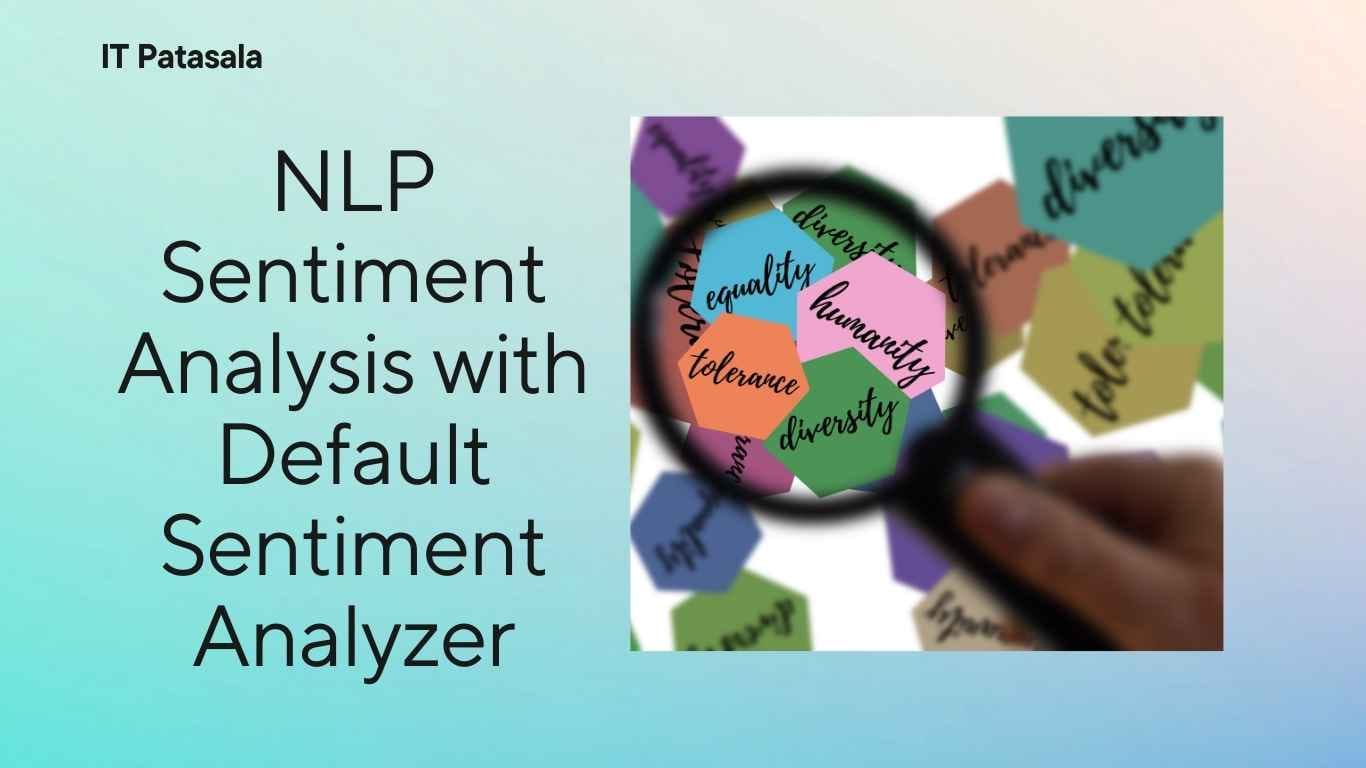NLP Sentiment Analysis with Default Sentiment Analyzer Best Guide 2025
💬 NLP Sentiment Analysis with Default Sentiment Analyzer: A Beginner’s Guide
In the age of data-driven decision-making, understanding public opinion, product reviews, and customer feedback is crucial. One of the most practical applications of Natural Language Processing (NLP) is Sentiment Analysis—and thanks to pre-built tools called Default Sentiment Analyzers, getting started has never been easier.
In this article, we’ll explore:
- What sentiment analysis is
- What a default sentiment analyzer means
- Which tools are commonly used (e.g., VADER, TextBlob)
- How to implement it using Python
- Real-world applications and examples
- Advantages and limitations
🧠 What Is Sentiment Analysis in NLP?
Sentiment Analysis (also known as opinion mining) is the process of identifying and classifying emotional tones within a body of text.
For example:
- “I love this product!” → Positive
- “This app crashes a lot.” → Negative
- “It’s okay, not great.” → Neutral
🤖 What Is a Default Sentiment Analyzer?
A Default Sentiment Analyzer is a pre-trained model that comes ready to use without requiring you to train it from scratch. These analyzers:
- Are based on NLP libraries like NLTK, spaCy, or TextBlob
- Have been trained on large text corpora
- Automatically classify input text as positive, negative, or neutral
They’re ideal for quick implementation, especially for beginners or projects with limited resources.
🔍 Why Use Default Sentiment Analyzers?
- No training data required
- Easy to integrate into apps and scripts
- Ideal for prototyping and testing
- Real-time sentiment scoring
- Great starting point for students and researchers
🧰 Popular Default Sentiment Analyzers
🗣️ 1. VADER (Valence Aware Dictionary and sEntiment Reasoner)
- Part of the NLTK package
- Rule-based and lexicon-based analyzer
- Designed for social media text, e.g., tweets, reviews
- Returns compound, positive, neutral, and negative scores
from nltk.sentiment.vader import SentimentIntensityAnalyzer
from nltk import download
download('vader_lexicon')
analyzer = SentimentIntensityAnalyzer()
print(analyzer.polarity_scores("This movie was absolutely fantastic!"))
📚 2. TextBlob
- Built on top of NLTK and pattern
- Provides sentiment as polarity (-1 to 1) and subjectivity (0 to 1)
- Very beginner-friendly
from textblob import TextBlob
text = TextBlob("I really love this book.")
print(text.sentiment) # Outputs Polarity and Subjectivity
🧠 3. spaCy + External Tools
spaCy does not offer built-in sentiment analysis by default, but it can be extended using:
- spaCyTextBlob (plugin)
- Transformers-based models
🔍 How Sentiment Analysis Works Under the Hood
Default analyzers typically use:
- Lexicons – Predefined lists of words labeled as positive/negative
- Rules – Algorithms to account for punctuation, negation, and intensifiers
- Heuristics – Logic for emoticons, slang, and uppercase text
Example (VADER):
- “NOT good” → Negative (negation detection)
- “Absolutely amazing!!!” → Highly Positive (intensifiers + punctuation)
🛠️ Step-by-Step: Implementing Sentiment Analysis Using VADER
🧾 Step 1: Install Required Libraries
pip install nltk
📥 Step 2: Import and Download Resources
import nltk
from nltk.sentiment.vader import SentimentIntensityAnalyzer
nltk.download('vader_lexicon')
🧪 Step 3: Create the Analyzer and Analyze Text
analyzer = SentimentIntensityAnalyzer()
sentence = "The customer support was terrible and unhelpful."
score = analyzer.polarity_scores(sentence)
print(score)
Output:
{'neg': 0.499, 'neu': 0.501, 'pos': 0.0, 'compound': -0.6588}
Here, compound is the most important value:
- 0.05 → Positive
- < -0.05 → Negative
- Between → Neutral
📊 Real-Time Example: Analyzing Tweets
tweets = [
"Loving the new iPhone update!",
"This weather sucks!",
"It's just another Monday, meh."
]
for tweet in tweets:
print(tweet)
print(analyzer.polarity_scores(tweet))
This is a great way to track brand sentiment or product feedback.
🌐 Real-World Applications
🛍️ 1. E-commerce Product Reviews
Analyze product ratings and user opinions to:
- Highlight top positive and negative aspects
- Improve product design
- Monitor brand health
💬 2. Social Media Monitoring
Companies use sentiment analyzers to:
- Analyze Twitter trends
- Detect viral posts
- Respond to crises or customer dissatisfaction in real-time
📰 3. News and Article Analysis
Track public sentiment on:
- Elections
- Celebrity scandals
- Public policy announcements
🏥 4. Healthcare Feedback
Hospitals use it to assess:
- Patient satisfaction
- Doctor behavior
- Insurance grievances
📺 5. Entertainment Industry
Movie studios analyze:
- Film reviews
- Trailer reactions
- Audience response post-release
⚙️ Advantages of Using Default Sentiment Analyzers
- Quick setup
- No need to build or train models
- Good for English and short texts
- Great for social media, reviews, and user-generated content
- Rule-based systems are explainable
⚠️ Limitations of Default Sentiment Analyzers
- Not ideal for complex, domain-specific language
- Can’t handle sarcasm, irony, or idioms effectively
- Limited support for multilingual content
- Subjectivity may be oversimplified
Example:
- “Yeah right, that was helpful 🙄” → Misclassified as neutral or positive
🧪 Comparison Table: VADER vs TextBlob
| Feature | VADER | TextBlob |
|---|---|---|
| Language Support | English only | Mostly English |
| Output Format | Compound score + 3 labels | Polarity + Subjectivity |
| Sarcasm Detection | Limited | Poor |
| Social Media Support | Excellent | Moderate |
| Training Needed | No | No |
💡 When to Use Default Sentiment Analyzers?
✅ Use When:
- You need fast insights
- You’re working with social media, product reviews
- You’re building a prototype or MVP
- You’re teaching sentiment analysis to beginners
❌ Avoid When:
- You need multilingual support
- The text includes domain-specific jargon
- Sarcasm or cultural context is critical
- You require high accuracy for production
📈 Advanced Alternatives
If you outgrow default analyzers, consider:
- Fine-tuned BERT models (e.g., BERTweet, RoBERTa)
- Transformers with HuggingFace library
- Custom Naive Bayes or SVM classifiers
- Deep learning (LSTM, CNN)
These offer more power, flexibility, and accuracy—but require more data and resources.
✅ Final Thoughts: Is the Default Sentiment Analyzer Enough?
Absolutely—especially if you’re getting started with NLP.
Default sentiment analyzers like VADER and TextBlob are:
- Reliable for everyday use cases
- Simple to understand and implement
- Perfect for learning and quick projects
But as your needs evolve, you may want to switch to custom-trained or deep learning models for better context and domain-specific accuracy.
Whether you’re building a sentiment dashboard or analyzing tweet storms—default sentiment analyzers are your NLP Swiss Army knife.
Also read these




